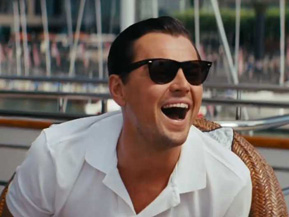Movie Review: The Wolf of Wall Street
By Matthew Huntley
January 6, 2014
A couple years later, following Black Monday of 1987 and Belfort’s own bouts with financial adversity, he has his own firm on Wall Street called Stratton Oakmont and is living in a New York City penthouse. He takes with him his closest friends and colleagues, including Donnie (Jonah Hill), his neighbor who envies Belfort for his yellow Porsche and tells him he’ll work for him right there and then if he can prove he made $70,000 in one month; Brad (Jon Bernthal), a bodybuilder with vulgar connections; and Nicky, a.k.a. Rugrat (P.J. Byrne), who’s smart and practical, but a bit of a weasel with a bad hairpiece.
All of this is just the beginning of Belfort’s undulating journey through the world of corporate malfeasance, womanizing, substance abuse and greed. Along for the ride is his mistress and eventual second wife, the beautiful and exotic Naomi (Margot Robbie), who proves she can be just as strong-willed and uncompromising as Belfort. Together, they dive headlong into extreme decadence and lavish spending, from yachts and helicopters to $38,000 meals and wild parties in Vegas.
But, as Belfort’s dad (Rob Reiner) says, “eventually the chickens come home to roost,” and Belfort fails to ask himself the all-important question: when is enough enough? (Charles Ferguson posed the same question to the men responsible for the 2008 financial crisis in Inside Job, and they too didn’t have an answer.) And so the story goes, Belfort’s reign eventually comes to an end courtesy of FBI Agent Patrick Denham (Kyle Chandler), who admits Belfort’s case was just sort of “dropped onto him.”
Narrative-wise, The Wolf of Wall Street doesn’t offer many surprises or fresh insight into the world of aggressive moneymaking and ceaseless self-indulgence. And Scorsese, like Belfort, seems to be under the impression that more automatically means better, as he accents the characters’ moral degeneration too much (how many times do we need to see them snort cocaine?) and pushes the familiar themes harder than necessary. It’s like he left the deleted scenes in the theatrical release, and there are several instances where we imagine editor Thelma Schoonmaker wanted to cut but was urged to keep going. This is a three-hour saga that could have been tighter and more effective at two and half.
Still, the movie is never boring, and there are many moments that stand out as truly original and memorable. One includes a funny sequence in which Belfort and Donnie take a handful of old Quaaludes (a hypnotic drug) and wait for them to kick in. When they finally do, the results are near fatal, but what happens up to that point is uproarious. Another is a shot of the drugs themselves. I’m not sure if it was done with special effects or just a really long lens, but director of photography Rodrigo Prieto gives us an extreme close-up of the pills and the level of detail is fascinating, especially because of what the drug represents.
Inspired moments like these are sprinkled throughout The Wolf of Wall Street, which make its extended runtime easier to bear. Overall, I would have preferred the movie delve into the personalities of the characters instead of just constantly showcasing their outrageous behavior, but the film has a pulsating energy and maintains a hold on us, even though we know where it’s going. We leave the theater satisfied but also thinking there’s more to the real Jordan Belfort, whose memoir served as the basis for Terence Winter’s screenplay. Wolf breaks down his lifestyle, I think another movie, perhaps a documentary, could be made that breaks down his psychology. Wolf of Wall Street makes us more than curious about it.
Continued:
1
2




